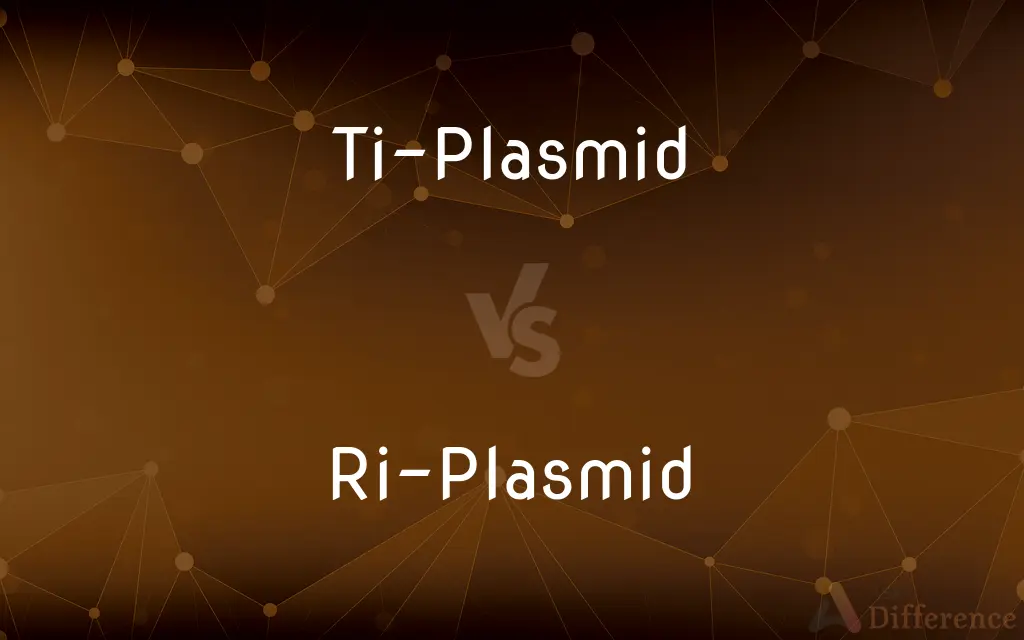Ti-Plasmid vs. Ri-Plasmid — What's the Difference?
By Tayyaba Rehman — Published on January 5, 2024
Ti-plasmid induces tumors in plants, while Ri-plasmid causes hairy root disease.

Difference Between Ti-Plasmid and Ri-Plasmid
Table of Contents
ADVERTISEMENT
Key Differences
The Ti-plasmid, found in Agrobacterium tumefaciens, is responsible for inducing crown gall tumors in plants. This plasmid transfers a portion of its DNA into the plant cell, causing uncontrolled growth. In contrast, the Ri-plasmid, present in Agrobacterium rhizogenes, leads to hairy root disease in plants. This plasmid transfers genes that result in prolific root growth.
Ti-plasmids are utilized in genetic engineering for plant transformation, allowing scientists to introduce new genes into plant genomes. Ri-plasmids, on the other hand, are used less frequently in genetic engineering but offer potential for root culture studies.
The Ti-plasmid’s transfer DNA (T-DNA) region causes tumor formation in plants by altering growth hormone levels. The Ri-plasmid’s T-DNA affects plant root growth, leading to the characteristic "hairy" roots.
Both Ti and Ri plasmids have been pivotal in understanding plant-microbe interactions and have applications in plant biotechnology. However, their effects on plants and usage differ significantly.
Comparison Chart
Host Bacterium
Agrobacterium tumefaciens
Agrobacterium rhizogenes
ADVERTISEMENT
Induced Plant Condition
Crown gall tumors
Hairy root disease
Main Application
Genetic engineering for plant transformation
Root culture studies
Effect on Plant Hormones
Alters growth hormones, causing tumors
Promotes excessive root growth
Usage in Biotechnology
Widely used for introducing new genes into plants
Used less frequently, potential for root studies
Compare with Definitions
Ti-Plasmid
Found in Agrobacterium tumefaciens.
Researchers isolated the Ti-plasmid from Agrobacterium tumefaciens for plant genetic engineering.
Ri-Plasmid
Causes hairy root disease in plants.
The Ri-plasmid was identified as the cause of hairy roots in infected apple trees.
Ti-Plasmid
Alters plant growth hormones.
The introduction of the Ti-plasmid caused uncontrolled growth in experimental plants.
Ri-Plasmid
Less common in genetic engineering.
Despite being less common, the Ri-plasmid has potential applications in biotechnology.
Ti-Plasmid
Tool for plant genetic engineering.
The Ti-plasmid was crucial in developing genetically modified crops resistant to pests.
Ri-Plasmid
Used for root culture research.
Researchers utilized the Ri-plasmid to generate root cultures for pharmaceutical studies.
Ti-Plasmid
Induces crown gall tumors in plants.
The Ti-plasmid was used to transfer beneficial genes into tomato plants.
Ri-Plasmid
Promotes excessive root growth.
Plants infected with the Ri-plasmid displayed a massive increase in root proliferation.
Ti-Plasmid
Transfers T-DNA to plant cells.
Scientists used the Ti-plasmid’s T-DNA transfer ability to study gene function in plants.
Ri-Plasmid
Found in Agrobacterium rhizogenes.
Agrobacterium rhizogenes carrying the Ri-plasmid was used for root culture studies.
Common Curiosities
What type of bacterium carries the Ti-plasmid?
Agrobacterium tumefaciens carries the Ti-plasmid.
What is the main difference between Ti-plasmid and Ri-plasmid?
Ti-plasmid causes crown gall tumors, while Ri-plasmid induces hairy root disease.
What disease does the Ri-plasmid cause in plants?
The Ri-plasmid causes hairy root disease.
How does the Ti-plasmid affect plant growth?
It alters growth hormone levels, causing uncontrolled tumor growth.
Are Ri-plasmids common in plant genetic engineering?
They are used less frequently, but they offer potential for root culture studies.
What is the main application of Ri-plasmids?
Ri-plasmids are used in root culture studies.
Do Ri-plasmids have T-DNA regions?
Yes, they also contain T-DNA regions for gene transfer.
Are plants infected with Ti-plasmid harmful?
While they cause tumors, these are generally not harmful to humans.
Can Ti-plasmids be used for genetic modification in plants?
Yes, Ti-plasmids are widely used for introducing new genes into plant genomes.
Can Ri-plasmids be used to study gene function in plants?
Yes, though less common, they can be used to study root-related gene functions.
Can Ri-plasmids promote plant growth?
They promote excessive root growth but can be detrimental to overall plant health.
Can Ti-plasmids be used in crop improvement?
Absolutely, they're instrumental in developing genetically modified crops.
Are Ri-plasmids beneficial for agriculture?
Their role is more limited, but they have potential in specialized applications.
Is it possible to use both Ti and Ri plasmids in the same plant?
In theory, yes, but it would require careful planning to avoid adverse effects.
Is the T-DNA region important in Ti-plasmids?
Yes, it's crucial for transferring genes into plant cells.
Share Your Discovery

Previous Comparison
Soda Crystals vs. Baking Soda
Next Comparison
Organic Acid vs. Inorganic AcidAuthor Spotlight
Written by
Tayyaba RehmanTayyaba Rehman is a distinguished writer, currently serving as a primary contributor to askdifference.com. As a researcher in semantics and etymology, Tayyaba's passion for the complexity of languages and their distinctions has found a perfect home on the platform. Tayyaba delves into the intricacies of language, distinguishing between commonly confused words and phrases, thereby providing clarity for readers worldwide.












































